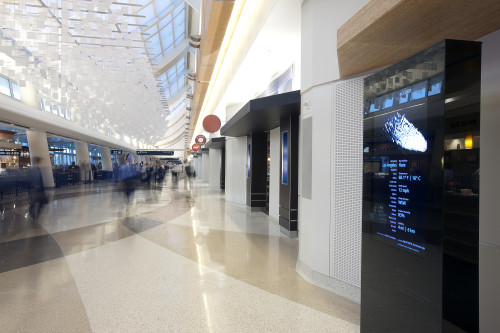
eCLOUD
UeBERSEE, Los Angeles, California, 2010
Description
Project brief: eCLOUD is a permanent art piece in the San Jose International Airport commissioned as part of its art and technology program. Our challenge was to create a technological artwork that was soothing and intellectually stimulating within a visually chaotic space such as an airport. In addition, as with all technology-driven endeavors in permanent locations, the goal was to be timeless and not show its age as technologies evolve.
Approach: When thinking about air travel, the movement and behavior of clouds in different kinds of weather enamored us. We created a “cloud” that would “travel” between cities and allow us to see what the weather was like around the world. To do this, we created a 108-feet long by 16-feet wide by 12-feet high dynamic sculpture made from unique liquid crystal tiles encased in polycarbonate that can fade between transparent and opaque states. Thousands of panels are arranged in the volume of an idealized cloud. Weather data drives the tiles to turn on and off, forming patterns that represent the weather in different cities. If it is raining, the volumetric patterns will make the sculpture look like it is raining. If it is windy in another city, the patterns will look as if they are blowing at the speed and in the direction the wind is blowing in that city. The cloud changes to a new city every 20 seconds.
A large black dynamic display sits at the front of the sculpture. It highlights the city that the eCLOUD is currently in, and displays its current weather characteristics such as sky conditions, wind speed, wind direction and temperature. The display also lists the cities that the cloud will travel to next. Custom software was created to search more than 100 cities for the most interesting weather and to put conditions in an order that makes for the most contrast between cities.
Effectiveness: The eCLOUD has become a landmark within the airport by creating an engaging narrative and using technology in unique and unexpected ways. It successfully makes ubiquitous data visible, both as art and as information. It has increased the profile of the airport as the gateway to the Silicon Valley.
From a distance, people are first drawn to the aesthetics of the large flickering sculptural piece. They watch it for a while, then wonder what it is. When they find the display and realize that the piece is driven by weather patterns, they gain even more interest. The travelers become more aware of the weather, the seasons and the world around them. With the eCLOUD, they are transported to the different cities and, for a moment, away from the drudgery of flying. The result, made possible by innovating technology, is an experience that is few and far between in airports.
Another benefit of the liquid crystal is that it consumes very little energy. The entire structure, consisting of almost 3,000 pixels, consumes the same amount of energy as one household light bulb.
Credits
- Design firm
- UeBERSEE
- Designers
- Dan Goods, Nikolaus Hafermaas, Aaron Koblin
- Programmer
- Daniel Massey
- Project manager
- Jamie Barlow
- Structural designer
- Simon Franklyn
- Fabricator
- International Rigging Inc.
- Client
- City of San Jose Public Art Program







